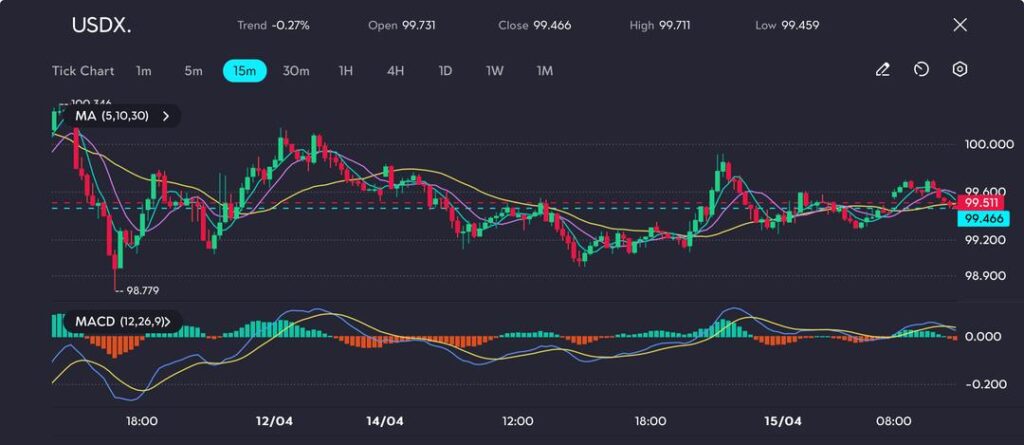
The US dollar is struggling to regain strength as markets react to mixed signals from Washington and growing expectations of interest rate cuts from the Federal Reserve. Recent policy reversals and investor shifts away from dollar assets have left the greenback on shaky ground, with confidence further dampened by global currency strength and economic uncertainty.
The US dollar showed limited stability in early Tuesday trading, lingering near multi-year lows after a turbulent week marked by abrupt shifts in tariff policy and a notable move away from dollar-denominated assets.
The US Dollar Index (USDX) settled at 99.466, down 0.27% on the day, following a sharp drop to its lowest level since July 2023. This occurred despite US Treasury yields touching their highest levels in two decades last week.
The primary pressure on the greenback stems from inconsistent signals out of Washington. Over the weekend, President Trump reversed course on a widely-criticised plan to implement broad-based import tariffs, opting to exclude several key Chinese consumer goods.
While markets initially viewed this as a relief, his comments implying the change might be short-lived introduced fresh uncertainty for traders.
Elsewhere, the Swiss franc surged to a 10-year high against the dollar last week, reflecting broader weakness. The euro and yen also held firm despite modest pullbacks.
The euro traded around USD 1.1324—just under its three-year peak of USD 1.1474—while the yen hovered at 143.53, slightly above Friday’s six-month low of 142.05.
Following a sharp drop to 98.779 on 12 April, the US Dollar Index has been consolidating in a narrow band. It has found temporary support in the 99.20–99.30 zone, but upside momentum remains limited, with 99.71 acting as a recent ceiling.

The index has since slipped back to 99.46 and is currently fluctuating near a confluence of the 5-, 10-, and 30-day moving averages, highlighting market indecision.
Momentum indicators are showing mixed signals. The MACD histogram is flat, and the signal lines are congested near the zero level—indicating a lack of clear direction.
Unless a fresh catalyst emerges, the index may continue to range-trade, with price action capped below the psychologically significant 100.00 level.
A breakout above 99.75–99.80 could reignite bullish sentiment, whereas a move below 99.20 would likely expose the previous low at 98.77.
Further weighing on the dollar, Federal Reserve Governor Christopher Waller noted on Monday that recent tariff shocks might justify interest rate cuts—even if inflation remains elevated.
This underscores the complex balancing act the Fed faces between managing inflation and supporting economic growth.
Markets reacted quickly, pricing in 86 basis points of rate cuts for the remainder of the year, according to LSEG data.
Meanwhile, US bond yields stabilised, with the 10-year yield holding at 4.354%—following last week’s dramatic 50-basis-point spike, the largest since 2001.
However, analysts view this pause as temporary, given the ongoing shift from Treasuries to global alternatives.
With US policy direction unclear and the Fed signalling increased flexibility towards rate cuts, the dollar remains under pressure.
Key technical support for the USDX stands at 98.75, while resistance is capped around 100.20.
Should upcoming data—particularly retail sales and jobless claims—disappoint, the index may continue its downward trajectory, potentially revisiting levels last seen in mid-2022.
Click here to open account and start trading.